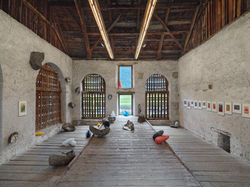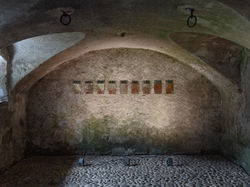Amshu Chukki Engadine Diaries
Amshu Chukki’s Engadin Diaries, is an exercise in encountering, observing, and occasionally absorbing a landscape the artist first arrived in 2014 and has since returned to. The mountains, valleys and waters – snow capped and lush, are both a site of tranquility and an aspiration to adventure. Specific to who you are and what you seek, time here is variable making each encounter unique. Chukki then returns to a methodology of frames, akin to stop motion to suspend time and rescue the landscape from the implications of temporality. The act is a constant rehearsal and a study of atmospheres and forms, instead of chronological histories or events. There is in fact no event here, no moment out of the ordinary - but an unraveling of the everyday-present.
This is most strongly demonstrated in Chukki’s oil paintings where skiers twist awkwardly while taking a fall. The compositions test the ductility of human bodies, and the lightness made possible by suspension. What happens when an active moment that is also violent, is rendered harmless and light with the freezing of time? One thing is that the landscape becomes its unnatural self, beautiful but devoid of its gravitation, implications and temperature. It is texture and sometimes an imposter. In these paintings for example, it is almost foamy, like waves carrying buoyant bodies.
This play continues in the wire sculptures where lines and bodies enmesh, and criss cross to a point where it is sometimes difficult to differentiate flesh from mountain. Bodies sometimes extend from hills and vice versa. It is in this trickery of foregrounding, through a process of layering landscapes that Chukki truly excels. The layering also produces a multiplication or duplications, sometimes synchronous, other times chaotic. The illusions of motion and multiplicity, especially through distance, that are produced by mountains are transferred and applied onto bodies while they play sport.
No wonder then, the artist uses the simultaneous colour printing technique of viscosity to render the strangeness of this seemingly familiar landscape. Chukki’s meticulously prepared copper plates have the mountains etched onto them through a process of hollowing, using acid. This depth, a shell of the mountain, is then loaded with color and pressed with force, to produce these dream-like works on paper. Studies of mountains, textures, rocks and debris, like they were under a night sky or a cloudy day, emerge from abstractions. It is as though the layers unfold to make an image apparent. Flaming reds, burnt oranges and wood greens against hues of pale blues, invoke both the audacity of dawn and the twilight hope of fading dusk.
On the floor of this 15th century barn, Chukki lays translucent sculptural replications of pine cones he’s collected from the valley over the years. A debris, or an ephemera, a specimen perhaps or a marker of time – these cones are ubiquitous to the area. The studies in resin continue to be unnatural, while keeping the textural identity intact. In many ways we are led to think about memory and replication; of encountering a site over and over again. When does it stop meeting us anew? or when do we become a part of it? A process of registration that eventually mutates into a slow process of deregistration. In a progression from translucent whites to yellows followed by oranges and blues, we possibly see the only record of time in the exhibition – but one based on weathers and seasons.
Engadin then forms both muse and site for this exhibition. In its folds, we trace (and claim) an aesthetic belonging to climates and colors, forms and textures – here mountains are flesh and bodies are taut - as they blend into a nature of snow.
Mario D’Souza





















